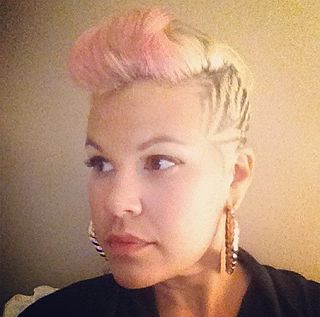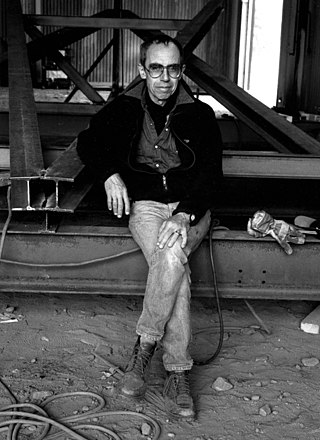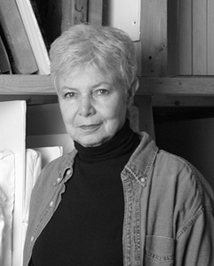
Socrates Sculpture Park is an outdoor museum and public park where artists can create and exhibit sculptures and multi-media installations. It is located one block from the Noguchi Museum at the intersection of Broadway and Vernon Boulevard in the neighborhood of Astoria, Queens, New York City. In addition to exhibition space, the park offers an arts education program, artist residency program, and job training.
Earl W. Brydges Artpark State Park is a 108-acre (0.44 km2) state park located in the Village of Lewiston in Niagara County, New York. The park, which is officially named after former New York State Senator Earl Brydges, is generally referred to as Artpark.
Sherrie Levine is an American photographer, painter, and conceptual artist. Some of her work consists of exact photographic reproductions of the work of other photographers such as Walker Evans, Eliot Porter and Edward Weston.
Gabriel Orozco is a Mexican artist. He gained his reputation in the early 1990s with his exploration of drawing, photography, sculpture and installation. In 1998, Francesco Bonami called Orozco "one of the most influential artists of this decade, and probably the next one too."

Isa Genzken is a German artist who lives and works in Berlin. Her primary media are sculpture and installation, using a wide variety of materials, including concrete, plaster, wood and textile. She also works with photography, video, film and collage.

Chitra Ganesh is a visual artist based in Brooklyn, New York. Ganesh's work across media includes: charcoal drawings, digital collages, films, web projects, photographs, and wall murals. Ganesh draws from mythology, literature, and popular culture to reveal feminist and queer narratives from the past and to imagine new visions of the future.
Agnes Denes is a Hungarian-born American conceptual artist based in New York. She is known for works in a wide range of media—from poetry and philosophical writings to extremely detailed drawings, sculptures, and iconic land art works, such as Wheatfield — A Confrontation (1982), a two-acre field of wheat in downtown Manhattan, commissioned by the Public Art Fund, and Tree Mountain—A Living Time Capsule (1992–96) in Ylöjärvi, Finland. Her work Rice/Tree/Burial with Time Capsule (1968–79) is recognized as one of the earliest examples of ecological art. She lives and works in New York City.

Jessica Stockholder is a Canadian-American artist known for site-specific installation works and sculptures that are often described as "paintings in space." She came to prominence in the early 1990s with monumental works that challenged boundaries between artwork and display environment as well as between pictorial and physical experience. Her art often presents a "barrage" of bold colors, textures and everyday objects, incorporating floors, walls and ceilings and sometimes spilling out of exhibition sites. Critics suggest that her work is informed by diverse artistic traditions, including abstract expressionism, color field painting, minimalism and Pop art. Since her early career, they have noted in her work an openness to spontaneity, accident and marginality and a rejection of permanency, monetization and disciplinary conventions that Stephen Westfall characterized as an "almost shocking sense of freedom."

Dannielle Tegeder is a contemporary artist who works with installation, animation and sound and is best known for her abstract paintings and drawings. She lives in Brooklyn, New York and maintains a studio at The Elizabeth Foundation in Times Square, Manhattan.

Heather T. Hart is an American visual artist who works in a variety of media including interactive and participatory Installation art, drawing, collage, and painting. She is a co-founder of the Black Lunch Table Project, which includes a Wikipedia initiative focused on addressing diversity representation in the arts on Wikipedia.
Cynthia Carlson is an American visual artist, living and working in New York.
Liz Deschenes is an American contemporary artist and educator. Her work is situated between sculpture and image and engages with post-conceptual photography and Minimalism. Her work examines the fluidity of the medium of photography and expands on what constitutes the viewing of a photograph. Deschenes has stated that she seeks to "enable the viewer to see the inconstancy of the conditions of display, which are always at play but sometimes hard to see." Her practice is not bound to a single technology, method, process, or subject, but to the fundamental elements of photography, such as light, paper, chemistry, and time.

Ree Morton was an American visual artist who was closely associated with the postminimalist and feminist art movements of the 1970s.

Jennie C. Jones is an African-American artist living and working in Brooklyn, New York. Her work has been described, by Ken Johnson, as evoking minimalism, and paying tribute to the cross-pollination of different genres of music, especially jazz. As an artist, she connects most of her work between art and sound. Such connections are made with multiple mediums, from paintings to sculptures and paper to audio collages. In 2012, Jones was the recipient of the Joyce Alexander Wien Prize, one of the biggest awards given to an individual artist in the United States. The prize honors one African-American artist who has proven their commitment to innovation and creativity, with an award of 50,000 dollars. In December 2015 a 10-year survey of Jones's work, titled Compilation, opened at the Contemporary Arts Museum in Houston, Texas.

Sara Greenberger Rafferty, is a multimedia artist working in painting, sculpture, photography, installation and performance. Her work focuses on gender and body politics in and through comedic performance. Rafferty teaches full-time at Pratt Institute and lives and works in Brooklyn, New York. Rafferty received a B.F.A. in Photography with Honors and Art History concentration from Rhode Island School of Design (RISD) and an M.F.A. in Sculpture and New Genres from Columbia University's School of the Arts. Her work was included in the 2014 Whitney Biennial and 2014 Hammer Biennial.

Nade Haley was an American visual artist whose work has been exhibited at numerous museums and galleries, and is held in public and private collections. After relocating from Washington DC, Haley lived and kept studios in New York City and in Cape Breton, Nova Scotia.

Elyn Zimmerman is an American sculptor known for her emphasis on large scale, site specific projects and environmental art. Along with these works, Zimmerman has exhibited drawings and photographs since graduating with an MFA in painting and photography at University of California, Los Angeles in 1972. Her teachers included Robert Heineken, Robert Irwin, and Richard Diebenkorn.
Jackie Saccoccio was an American abstract painter. Her works, considered examples of gestural abstraction, featured bright color, large canvases, and deliberately introduced randomness.

Heide Fasnacht is a New York City-based artist who works in sculpture, drawing, painting and installation art. Her work explores states of flux, instability and transformation caused by human action and natural events. Since the mid-1990s, she has been known for sculptures and drawings that recreate momentary phenomena such as sneezes, geysers and demolitions—in sometimes abstract or cartoony form—that are temporally and spatially "frozen" for consideration of their aesthetic, perceptual, social or sensate qualities. In the late 2010s, she has expanded these themes in paintings that examine lost and neglected childhood sites, such as playgrounds and amusement parks. ARTnews critic Ken Shulman has described her work as "chart[ing] the fluid dialogue between second and third dimensions, motion and inertia, creation and ruin."

Cristos Gianakos is an American postminimalist artist known for his large-scale ramp sculptures and installations. He lives and works in New York, where he has been teaching at the School of Visual Arts since 1963.


















